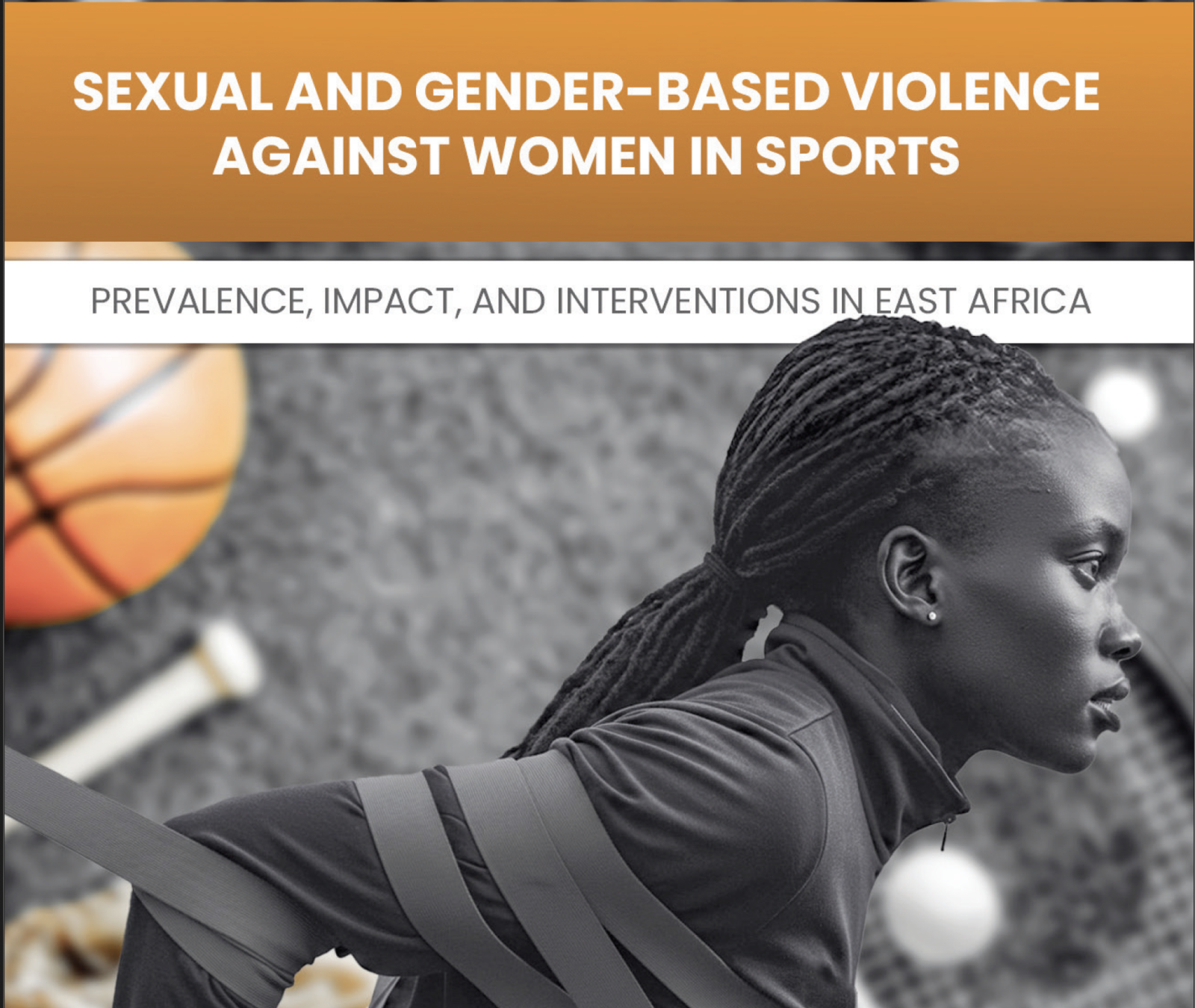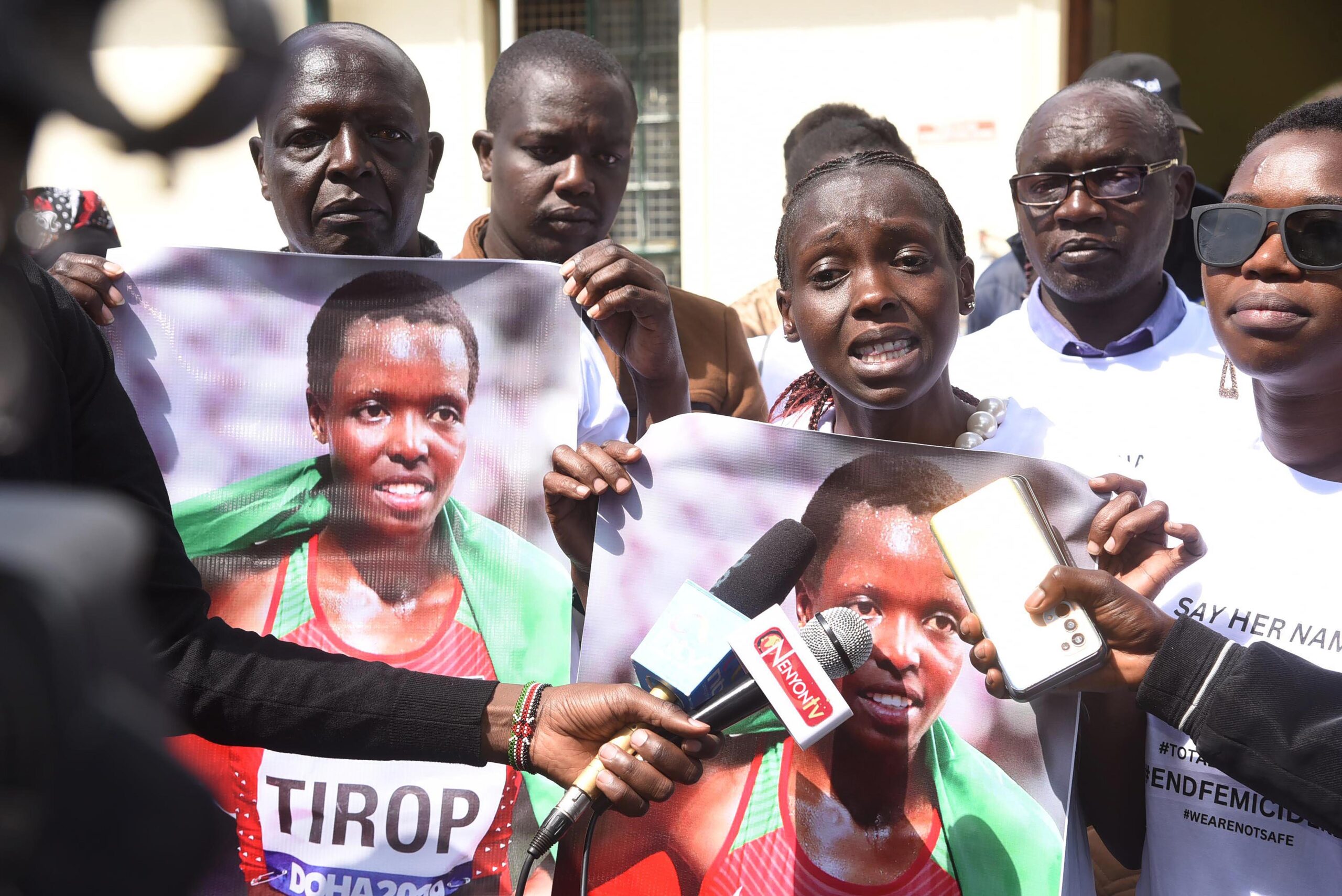Watch more from Fuller: Uncovering claims of sexual assault at protests in Kenya
60% of sportswomen in East Africa have either experienced or witnessed sexual and gender-based violence. A culture of silence, the power of male coaches and difficulty getting justice explain why the problem persists.
The courtroom was quiet, but the tension was deafening. Dressed in white T-shirts emblazoned with Kenyan runner Agnes Tirop’s face and the words “Say Her Name”, her family and fellow athletes sat staring at an empty space where the defendant should have been. The same space where, four times now, the man accused of killing her has failed to appear.
They already knew what was coming.
When the investigating officer Philip Ndeto stood to speak, it was to confirm their fears: Ibrahim Rotich, Tirop’s estranged husband and ex-coach, the key suspect in her November 2021 murder, had absconded again.
In October 2021, Tirop — one of Kenya’s brightest athletic stars — was found dead at the home she shared with her sisters. One sister recalled hearing her having a heated argument the night before with Rotich, a man around 15 years her senior whom she first met when she was still at school and he offered to be her coach. She was just 25 when she died.
Tirop’s case was no isolated tragedy. In the weeks after her death, protesters demanded action to halt the scourge of domestic abuse against female athletes. Then, in September, the Ugandan Olympic runner Rebecca Cheptegei died after being doused in petrol and set on fire by her former partner at her home in western Kenya. It later emerged that Cheptegei had reported the abuse to police prior to the attack.

A recent study by The Aga Khan University shows 60% of sportswomen in East Africa have either experienced or witnessed sexual and gender-based violence. But most never speak out. Why? Fear, and a system that rarely holds anyone accountable.
Drawing on survey results and in-depth interviews with athletes and other stakeholders in Kenya, Uganda and Tanzania, the study found that verbal abuse, sexual harassment, and emotional abuse are common violations faced by women in sports. The perpetrators are often those closest to them: coaches, teammates and even fans.
Young professional and competitive-level athletes were the most vulnerable, the study found. Many rely on coaches for career advancement and international exposure, but that power imbalance leaves them exposed to exploitation.
“It’s heartbreaking,” said one athlete anonymously. “You train your whole life to succeed, only to find the very people meant to support you are the ones taking advantage.”
A basketball coach who spoke to The Fuller Project on condition of anonymity described a deep-rooted rot in the sector that extends beyond his chosen sport.
“I know of coaches who demand sex from players in exchange for small favors like securing a spot on the team. This has sadly become the norm, and federation officials are often complicit,” he said. “It’s not just a basketball issue; it cuts across athletics, volleyball, and other women’s teams, especially those that are high-profile.”
The coach explained that young female athletes are the most vulnerable group, especially those who “are hoping to secure scholarships abroad, particularly in Europe and the U.S.”
“These coaches often have direct access to international agents,” he added. “They use this power dynamic to exploit young girls desperate to further their careers.”
Sexual violence in sport – the underlying factors
Tellingly, only 17% of respondents to the Aga Khan University survey reported personal experiences. Another 25% chose not to answer at all.
“These findings reveal that athletes’ failure to report incidents of SGBV reflects not only a pervasive culture of fear but also a structural breakdown within the sports ecosystem—a failure to safeguard athletes from gender-based violence,” the study’s authors wrote.
“It takes away your voice,” said one respondent, quoted anonymously in the report. “You start to doubt yourself and question everything: your worth, your talent, even your memories. And when you speak up and nothing happens — or worse, you’re punished for it — that silence becomes a wound that never heals. You lose the sport you loved… but also the self you were before it all happened.”
Dr. Hebson Owilla, one of the study’s co-authors, said the findings must spur “urgent” action. “It’s not just about the numbers. It’s about what the numbers are telling us: that there’s an urgent need to support sports federations and associations to create safer, more secure environments for women.”

Another issue is that regional sports bodies are overwhelmingly led by men. A 2022 report by Kenya’s Gender Welfare and Equity in Sports Commission, showed 75% of team and technical managers are men, and 80% of sports federations are male-led.
Evelyne Opondo, Africa director at the International Centre for Research on Women, advocates for leadership quotas in sports federations, supported by transparent recruitment processes, targeted mentorship and leadership training.
“True transformation requires a structural recalibration of power within the sports sector, alongside the unapologetic assertion of women’s voices,” Opondo said. “Only then can Kenya’s sporting ecosystem become a space where every athlete and staff member can thrive free from violence.”
Opondo also urged authorities to put in place “clear codes of conduct with precise definitions of misconduct and survivor-centred enforcement mechanisms to prevent and address gender-based violence against sportswomen.”
In pursuit of justice
In November 2024, Kenya established the Gender Protection and Implementation Committee, led by two-time world marathon champion Catherine Ndereba. The committee was tasked with developing policies to curb gender-based violence and creating a safer, more supportive environment for women in sports.
Kenya’s top government official in charge of sports, Elijah Mwangi, told The Fuller Project that the committee had already presented him with a three-year plan and said he was pleased with the progress.
But the problem goes far beyond the sports bodies. Watching the slow pace of justice in Tirop’s case, it is little wonder that others have chosen to suffer in silence.
“Too many of these cases are being dragged through the courts with no end in sight,” said Jackson Tuwei, who heads Athletics Kenya. “We need to find a way for these cases to be expedited so victims receive timely justice.”
In the nearly three and a half years since Tirop was killed in her home, her loved ones have shown up in courtrooms, at vigils, and on tracks, carrying her memory and demanding justice. The accused, Rotich, has since February repeatedly skipped court, and disappeared without a trace.
“All we’ve ever wanted is justice,” said Kenyan athlete Martha Jerop, who was in court standing in solidarity with Tirop’s family. “This was supposed to be a strong message, that no woman should die like Agnes. But it feels like we’re being left to fight this alone.”
As they have done so many times before, Agnes Tirop’s family plans to be in court on July 23, clinging to hope that this time, the trial will go ahead. Her father, Vincent Tirop, says his family is retraumatized by each new court appearance.
“My daughters were living with Agnes. They are key witnesses,” he said. “For us, justice delayed is not just justice denied, it’s a wound that keeps reopening.”
Want to get more reporting from The Fuller Project directly into your inbox? Subscribe to our newsletter.



